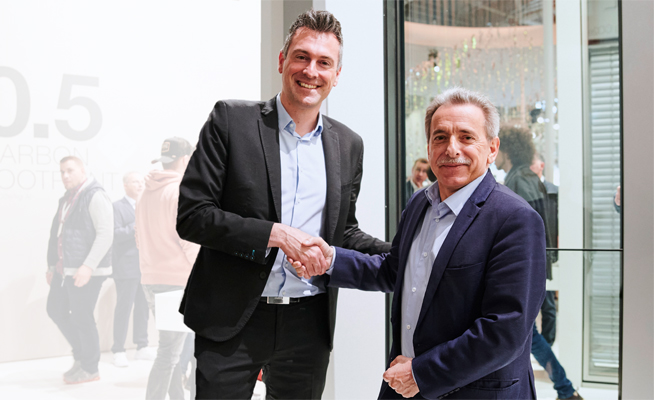Saint-Gobain Glass and Hydro Building Systems are joining forces to drive decarbonisation by helping the building industry design sustainable façades that have circularity built in.
The two companies are leading the way through the use of low embodied carbon products thanks to a high percentage of recycled materials: specifically, the Saint-Gobain Glass ORAÉ® glass substrate and Hydro Building Systems aluminium façade products manufactured from Hydro CIRCAL® 75R.
ORAÉ® is a new glass substrate with the world’s lowest carbon footprint. According to its EPD, ORAÉ® has a verified carbon footprint value of 6.64kg CO2 eq./m² (for a 4 millimetre substrate), a reduction of 42 percent compared to the Saint-Gobain Glass European baseline clear glass. This has been achieved through the use of renewable electricity and a recycled content of 64 percent.
Hydro CIRCAL® 75R, first launched in 2019, is a prime quality aluminium made with a minimum of 75 percent recycled post-consumer scrap aluminium. Hydro CIRCAL® 75R has a carbon footprint among the lowest in the world: 2.3 kilograms of CO2 per kilogram of aluminium.
With a shared dedication to sustainable development, Saint-Gobain Glass and Hydro Building Systems, which includes the TECHNAL, WICONA, SAPA, and DOMAL brands, as well as recently acquired HUECK, are committed to helping developers and specifiers create more sustainable, lower embodied carbon buildings.
Marion Portenseigne, BU Glass Façade Specification Director at Saint-Gobain Glass, said, “We share with Hydro Building Systems the same ambition to accelerate decarbonisation in the construction sector. This partnership will enable us to increase the awareness of low carbon solutions for façades. This means common specification training for our specifiers to get to know the counterpart offer, then joint communication actions that started with BAU fair in Germany last April, and shared initiatives on specific projects to promote both solutions.”
Bruno Mauvernay, Managing Director Business Unit Glass Façades at Saint-Gobain, added, “Together, thanks to the combination of our low carbon materials, ORAÉ® and CIRCAL® 75R, we are now able to promote a low carbon façade which contains around 50 percent less embodied CO2 compared to a standard façade, bringing developers and architects along with us into our commitment towards carbon neutrality.”
Lucile Souyri, Sustainability Manager at Hydro Building Systems, commented, “For many years, sustainability has been a core part of our strategy as a business and the driving force behind our commitment to low carbon innovation. We are delighted to be able to work alongside Saint-Gobain Glass in setting a new standard and leading the way towards a more sustainable construction environment. Thus, our partnership includes the elements presented by Marion earlier, and moreover working together to ensure that glass and aluminium from end-of life façades will be recycled. However, this will only be achieved through closer collaboration with teams of both companies involved, from the initial design stages to the completion of the building.”
Henri Gomez, Vice President at Hydro Building Systems, continued, “Ten years ago, we started our journey towards decarbonization of the buildings with CIRCAL® 75R, and we continue to lead the way with CIRCAL® 100R. And now by partnering with Saint-Gobain Glass, a strong player from the building and construction sector, we go beyond regulations.”






